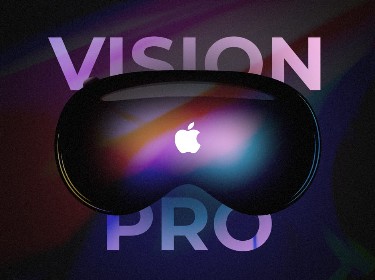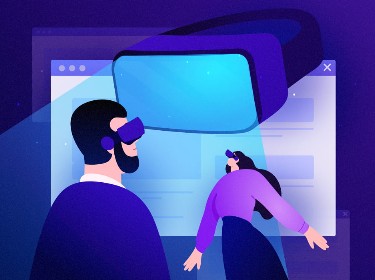As augmented reality technology gains wider traction, businesses in a variety of industries have rushed to adopt it in their workflows. Manufacturers stand to benefit from AR too, by using it to streamline complex processes and strengthen employee safety.
Augmented reality (AR) used to be viewed as a marketing tool for entertaining consumers, as well as an important element of popular games such as Pokémon Go.
These days, however, AR has evolved into a robust and solid go-to tool whose global software market size is forecast to reach $137.14 billion by 2028.
AR does indeed possess an enormous capacity to upend and streamline workflows within different domains, prompting previously skeptical stakeholders to U-turn and embrace the tech.
Manufacturers can also leverage augmented reality in their operations to become more productive, competitive, and sophisticated, and to enhance numerous different processes.
Read on to learn more about augmented reality development in manufacturing and its benefits, and explore five key ways to use AR in manufacturing processes.
Discover how augmented and virtual reality is used in the construction industry
What is the state of manufacturing in 2023?
Although we are witnessing growth in terms of the number of new factories, the entire manufacturing industry is experiencing some pressing problems, the most significant being a lack of skilled personnel, unstable economic conditions, an increase in energy demand and consumption, and tense global competition.
Notwithstanding all these challenges, however, manufacturing is still surpassing the expectations of previous years.
According to Deloitte’s 2023 manufacturing industry outlook, to maintain growth and remain competitive, manufacturing stakeholders need to consider the following five industry trends:
- Investing in advanced technologies to help mitigate risk
- Implementing a broad range of talent management strategies to reduce voluntary exit rates
- Relying on time-tested mitigation strategies with enhanced tactics to achieve supply assurance
- Taking a holistic approach to smart factory initiatives to unlock new horizons
- Focusing on corporate social responsibility
As far as the “investing in advanced technologies” point is concerned, the manufacturing industry can make the grade by turning to an expert enterprise blockchain development company, artificial intelligence, the Internet of Things, and virtual and augmented reality integration vendors. The latter in particular boasts a tremendous capacity to address the industry’s core pain points and help manufacturers become more productive.
Many industry leaders view AR/VR technology as an inseparable element of the transformation of the manufacturing domain. For example, in February 2023, Huawei showcased its upgraded Factory Network Solution for the manufacturing sector at the Mobile World Congress (MWC) 2023, which foresaw the implementation of augmented reality technology for smart factories.
5 ways to use augmented reality in modern manufacturing
![]()
So far, AR development services in manufacturing have helped enhance employee training and upskilling, quality control and maintenance, product design and assessment, logistics and warehouse management, and customer support.
Let’s delve into each specific use case and find out more about the impact of AR in manufacturing.
1. Employee training and upskilling
Manufacturers can make use of specialized AR devices and applications to help both new and experienced workers train and acquire new skills.
AR facilitates the simulation of real-life activities in a semi-virtual environment, enabling manufacturers to execute activities and create specialized contexts without physical equipment and materials.
Thanks to augmented reality solutions, new workers can be safely and effectively trained in all crucial manufacturing processes and taught how to operate expensive and complex machines and equipment. If they make a mistake or do something wrong during their training, the system will issue a real-time notification in the form of a visual warning or audio prompt.
By interacting with three-dimensional models and holograms of manufacturing equipment as well as realistic simulations of manufacturing workflows, employees can gain a better understanding of their responsibilities and duties while avoiding hazardous situations.
B2B skilling startup Cusmat is an example of a company offering businesses AR-enabled solutions for training employees. It is set to help firms boost retention rates and on-job performance training via its augmented reality, cloud-based learning management system.
2. Quality control and maintenance
The 3D imaging capabilities offered by augmented reality are increasingly used for efficient and accurate manufacturing, contributing to the growth of the market.
A worker wearing AR glasses will enjoy a high-quality, 360-degree representation of a product or element, and be able to view it from all sides. The enhanced visualization of products helps manufacturers prevent defects during the production stage as well as view and effectively fix anomalies during product exploitation.
With AR, manufacturers can also connect and cooperate with other experts from across the globe to work on and repair issues together. This, consequently, fosters continuous production and enables non-disruptive performance.
Coupled with the advances of the Internet of Things, augmented reality can deliver even greater results. So, manufacturers can consider embedding IoT sensors into their product components that will send data and alerts about product states and report issues.
Check out this real estate platform for generating 360° tours
3. Product design and assembly
Thanks to the visualization capabilities offered by augmented reality, manufacturers can enjoy ample product design opportunities. With 3D AR capabilities, manufacturing designers and technicians can visualize and interact with the product in detail and work on its features (which could mean either adding new ones or removing unnecessary parts).
For example, Honda utilized the advances of VR and AR to enhance the quality and appeal of its future products, including the all-electric 2024 Honda Prologue and the 2023 Honda Pilot TrailSport.
Augmented reality applications allow workers to access convenient hands-free and voice-controlled manufacturing guidelines rather than wasting their time searching for information across multiple spreadsheets. This creates faster access to resource materials, enabling workers to focus more on their surroundings and key tasks.
Moreover, by using augmented reality in manufacturing, product developers can create 3D prototypes of new products and introduce them to executives and senior stakeholders, who can view the product before its launch and assess its characteristics.
4. Logistics and warehouse management
With augmented reality glasses and other AR hardware, manufacturing workers will be able to organize goods and equipment that have to be moved or managed in warehouses.
AR glasses can guide workers through the warehouse area so that they can find and select the necessary items among millions of other stored objects. With AR, workers can quickly scan data and retrieve and upload the items needed onto the loading dock.
In February 2023, researchers from the Massachusetts Institute of Technology presented an augmented reality headset that gives the wearer X-ray vision. The team tested the device in a mock warehouse environment and reported that it could localize hidden items to within 9.8 centimeters, on average. According to MIT, the AR headset enabled users to pick up the correct item with 96% accuracy.
5. Remote customer support
Augmented reality helps customers connect directly with technicians or maintenance personnel and ask for a consultation, regardless of their physical location.
For instance, if a client experiences trouble with their vehicle, they can reach out to an expert who will use AR technology to provide detailed instructions. They will view the customer’s environment through a video feed in order to guide them through the repair process. The two parties can engage in collaborative problem-solving without having to waste their time getting to and from the relevant location.
If you think that this is next to impossible, take a look at TechSee. The company recently launched a bespoke visual engagement solution powered by computer vision service and augmented reality that enables enterprises around the world to deliver better customer assistance, enhance service quality, and reduce costs.
Not only manufacturing: discover how augmented reality can transform the wine industry
What are the benefits of using augmented reality in manufacturing?
![]()
According to McKinsey’s Technology Trends Outlook 2022, business leaders stand to enjoy numerous benefits from augmented reality, such as increased innovation, the introduction of new products and services, scalability of training, and many more.
All these benefits apply to manufacturing in particular, but the industry is also set to enjoy advantages such as greater employee safety, enhanced operational efficiency, better decision-making, improved product quality, and reduced costs.
Greater employee safety
Augmented reality provides workers with the opportunity to acquire and hone their professional skills in a safe, experiential environment that does not involve any interaction with actual machinery. This enormously enhances employee safety and inspection levels and enables them to practice different activities without much risk.
Enhanced operational efficiency
By implementing augmented reality in manufacturing processes such as product design and quality checks, manufacturers can identify and diagnose issues as early as possible and eliminate them at short notice. This is because AR can provide employees with a 3D representation of a certain element, which they can inspect inside and out. As a result, manufacturing businesses can deliver their products to market faster and ensure better performance.
In addition, AR-enabled instructions assist workers in predictive troubleshooting while minimizing issues that cause rework, thus streamlining complex assembly tasks.
Better decision-making
Because augmented reality grants access to lots of data points in a single view, manufacturers can make more informed decisions.
The visual representation of data empowers workers to view tendencies as well as contextualized information and insights into equipment performance. This speeds up problem-solving and helps optimize the entire process.
Improved product quality
Augmented reality solutions for manufacturing make it possible to effectively design three-dimensional models as well as develop virtual prototypes. This gives manufacturing designers an improved vision of the product-to-be, view it from all sides, and deliver a high-quality solution in the long run.
AR also allows workers to interact with different departments, and work together to make a more robust and better-performing product.
Reduced costs
Even though augmented reality is rather expensive to implement throughout an entire manufacturing enterprise, the benefits that the technology offers are bound to help manufacturers significantly minimize costs and spending in the long term.
AR will make it possible to optimize efficiency, reduce human error, assist in training staff and teaching them new skills, and even help win customer loyalty, which, consequently, will allow manufacturers to thrive.
Find out how augmented and virtual reality can upend the fashion industry
Closing thoughts
Augmented reality has established itself as a powerful business trigger for manufacturing and is set to be used extensively within the industry in the future.
By leveraging AR, manufacturers can tap into new business opportunities, gain a competitive edge in their business workflows, establish a safer working environment, and deliver high-quality products.
If you are ready to experience the transformative power of augmented reality, reach out to our team of augmented and virtual reality development specialists for help. We will turn your initiatives into lasting commercial success and deliver a bespoke solution that will enable your business to thrive.
Disclaimer: The information provided in the article is for educational purposes only. It does not constitute advice or recommendations for embracing or investing in augmented reality technology. Please seek professional advice before taking financial risks.




